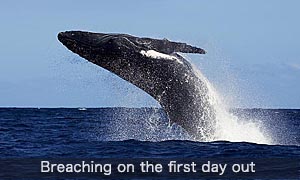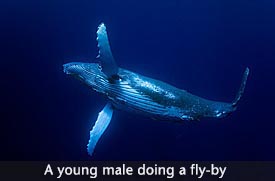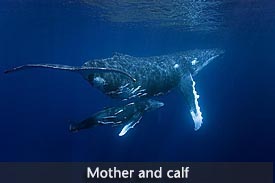 It’s been a really productive couple of weeks so far, with decent weather almost every day. We’ve had a few days of strong winds recently, which has kept us from some areas the whales frequent, but that hasn’t prevented us from having incredible encounters.
It’s been a really productive couple of weeks so far, with decent weather almost every day. We’ve had a few days of strong winds recently, which has kept us from some areas the whales frequent, but that hasn’t prevented us from having incredible encounters.
Humpbacks whales are actually fairly easy to distinguish once you become accustomed to seeing them. The have unique dorsal fins, patterns on the undersides of their tails, and unique patterns on their bodies. The body pattern of the southern hemisphere humpbacks is particularly easy to distinguish, due to their white bellies. (Northern hemisphere humpbacks tend to be dark all over, which makes it slightly more difficult to identify them.)
So far, I’ve identified nine distinct mother/ calf pairs. Based on previous years, this isn’t particularly high, but it’s early yet, and the number of mother/ calf pairs seems to grow day-by-day.
 What’s really caught my attention this year though, is the frequency of encounters we’ve had with young whales — probably in the one to four year-old range. Young whales are around each year, but so far, the frequency of encounters this year seems to suggest that there are more than usual.
What’s really caught my attention this year though, is the frequency of encounters we’ve had with young whales — probably in the one to four year-old range. Young whales are around each year, but so far, the frequency of encounters this year seems to suggest that there are more than usual.
Given the abundance of mother/ calf pairs in the past couple of years, hopefully this means that the young ones have successfully negotiated the long summer trips to the Antarctic and returned to Tongan waters to rest and compete for status and mates.
 So far, I’ve encountered many young bulls travelling together in pairs, a pattern consistent with previous years. They swim together, play a bit, rest at shallow depth, move on and repeat the pattern. Occasionally, the pairs meet up with single whales or other pairs, and a frenzy of high-testosterone activity ensues — swimming rapidly, chasing one another, snorting, “crocodile-ing”, tail-slapping, breaching…the works.
So far, I’ve encountered many young bulls travelling together in pairs, a pattern consistent with previous years. They swim together, play a bit, rest at shallow depth, move on and repeat the pattern. Occasionally, the pairs meet up with single whales or other pairs, and a frenzy of high-testosterone activity ensues — swimming rapidly, chasing one another, snorting, “crocodile-ing”, tail-slapping, breaching…the works.
Watching these encounters year-after-year, I’m reminded of the mock fights young social mammals engage in on land to establish pecking order and individual status. Like their land-bound counterparts, the young whales don’t seem to hurt one another, but it’s difficult to know for sure given that most of the activity takes place at depth.
Once these young bulls grow up, the fights seem to get more serious. For example, I’ve been among a group of eight large bulls jostling with one another for the attention of a single female. In this instance, tail slaps, head butts and body slams hit home, with the resulting “thuds” and “booms” reverberating through the water. A few times, the older bulls drew blood; it’s possible to spot the scars from these types of battles, which the older males seem to wear as badges of honour.
 I’m only posting low-res files to this blog to conserve space on my server. Slowly but surely, I’ll be uploading larger versions of the images here plus other images to my Flickr page.
I’m only posting low-res files to this blog to conserve space on my server. Slowly but surely, I’ll be uploading larger versions of the images here plus other images to my Flickr page.
Off to see my cetacean friends…